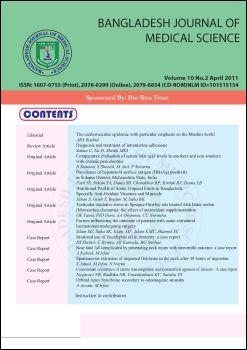Testicular oxidative stress in Sprague-Dawley rats treated with bitter melon (<i>Momordica charantia</i>): the effect of antioxidant supplementation
DOI:
https://doi.org/10.3329/bjms.v10i2.7805Keywords:
Momordica charantia, malondialdehyde, ascorbic acid, testosteroneAbstract
Objective: An important mediator of testicular injury is oxidative stress; the implicating pathway has been pointed at a free radical mechanism by researchers. This article, investigates the effect of bitter melon (Momordica charantia) (MC) seed extract and antioxidant supplementation in the testes of Sprague-Dawley (S-D) rat.
Methodology: Ninety male S-D rats, weighing between 110- 214 g, were assigned randomly into six main Groups A to F. Group A was administered 50 mg/100 g of MC extract orally, between 6 to 16 weeks. Group B were pre-treated with ascorbic acid (AA) 0.01mg/kg, three days/week, α-tocopherol (AT) 20 mg/kg, five days/week and both test solutions (TS) i.e. AA and AT; 0.01 and 20 mg/kg, three and five days/week for 8 weeks. This was followed by administration of the extract at dose and duration as in A. Group C received the extract for 8 weeks and afterwards post-treated for another 8 weeks with AA, AT and both TS (as above). Group D in addition to the extract administration were treated with AA, AT and both TS in dose and duration similar to B above. Group E had AA, AT and both TS alone for 8 weeks. Group F served as the control subjects. The animals testicular tissues were processed for malondialdehyde (MDA) and AA concentrations. Serum testosterone (TT) assay was done from left ventricular blood.
Results: The extract administered for 6, 8 and 16 weeks produced significantly (p < 0.05) increased testicular MDA (1.74 ± 1.15, 1.84 ± 0.38 and 2.38 ± 0.40) compared to control (0.38 ± 0.02, 0.38 ± 0.03 and 0.35 ± 0.02) and decreased AA (0.01± 0.02, 0.01± 0.01 and 0.00± 0.01) compared to control (0.15 ± 0.02, 0.12 ± 0.02 and 0.13 ± 0.02). There was also an associated significant decrease (p < 0.05) in peripheral TT levels compared to control. The extract produced responses that showed no prophylactic rather modulatory effect with TS.
Conclusion: These findings suggest that the extract resulted in changes in the testicular oxidative status. This may play a role in testicular dysfunction that may compromise fertility.
Key words: Momordica charantia; malondialdehyde; ascorbic acid; testosterone.
DOI: http://dx.doi.org/10.3329/bjms.v10i2.7805
Bangladesh Journal of Medical Science Vol.10 No.2 Apr’11 pp.104-111
Downloads
361
248
Downloads
How to Cite
Issue
Section
License
Authors who publish in the Bangladesh Journal of Medical Science agree to the following terms that:
- Authors retain copyright and grant Bangladesh Journal of Medical Science the right of first publication of the work.

Articles in Bangladesh Journal of Medical Science are licensed under a Creative Commons Attribution 4.0 International License CC BY-4.0.This license permits use, distribution and reproduction in any medium, provided the original work is properly cited.- Authors are able to enter into separate, additional contractual arrangements for the distribution of the journal's published version of the work (e.g., post it to an institutional repository or publish it in a book), with an acknowledgement of its initial publication in this journal.
- Authors are permitted to post their work online (e.g., in institutional repositories or on their website) as it can lead to productive exchanges, as well as greater citation of published work.




